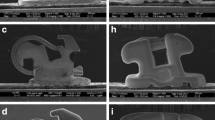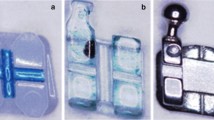Abstract
Objectives
Bracket material, bracket design, archwire material, and ligature type are critical modifiers of friction behavior during archwire-guided movement of teeth. We designed this in vitro study to compare the friction losses of ceramic injection-molded (CIM) versus pressed-ceramic (PC) and metal injection-molded (MIM) brackets—used with different ligatures and archwires—during archwire-guided retraction of a canine.
Methods
Nine bracket systems were compared, including five CIM (Clarity™ and Clarity™ ADVANCED, both by 3M Unitek; discovery® pearl by Dentaurum; Glam by Forestadent; InVu by TP Orthodontics), two PC (Inspire Ice by Ormco; Mystique by DENTSPLY GAC), and two MIM (discovery® and discovery® smart, both by Dentaurum) systems. All of these were combined with archwires made of either stainless steel or fiberglass-reinforced resin (remanium® ideal arch or Translucent pearl ideal arch, both by Dentaurum) and with elastic ligatures or uncoated or coated stainless steel (all by Dentaurum). Archwire-guided retraction of a canine was simulated with a force of 0.5 N in the orthodontic measurement and simulation system (OMSS). Friction loss was determined by subtracting the effective orthodontic forces from the applied forces. Based on five repeated measurements performed on five brackets each, weighted means were calculated and evaluated by analysis of variance and a Bonferroni post hoc test with a significance level of 0.05.
Results
Friction losses were significantly (p < 0.05) higher (58–79 versus 20–30 %) for the combinations involving the steel versus the resin archwire in conjunction with the elastic ligature. The uncoated steel ligatures were associated with the lowest friction losses with Clarity™ (13 %) and discovery® pearl (16 %) on the resin archwire and the highest friction losses with Clarity™ ADVANCED (53 %) and Mystique (63 %) on the steel archwire. The coated steel ligatures were associated with friction losses similar to the uncoated steel ligatures on the steel archwire. Regardless of ligature types, mild signs of abrasion were noted on the resin archwire.
Conclusions
The lowest friction losses were measured with rounded ceramic brackets used with a stainless-steel ligature and the resin archwire. No critical difference to friction behavior was apparent between the various manufacturing technologies behind the bracket systems.
Zusammenfassung
Ziel
Das Bracketmaterial und -design, das Bogenmaterial sowie die Art der Ligatur haben entscheidenden Einfluss auf das Reibungsverhalten bei einer bogengeführten Zahnbewegung. Ziel dieser in-vitro-Untersuchung war es, den Reibungsverlust von Keramikspritzguss-Brackets im Rahmen einer bogengeführten Eckzahnretraktion in Kombination mit verschiedenen Ligaturen und Bögen zu messen und mit nach anderen Verfahren hergestellten Brackets zu vergleichen.
Material und Methoden
Untersucht wurden 5 verschiedene durch Keramikspritzguss (Ceramic Injection Molding, CIM) hergestellte Brackets (Clarity™, Clarity™ ADVANCED, discovery® pearl, Glam, InVu), 2 gepresste Keramikbrackets (Inspire Ice, Mystique) und 2 MIM (Metal Injection Molding)-Brackets (discovery® smart, discovery®). Die Messungen erfolgten an Bögen aus Edelstahl (remanium®) und glasfaserverstärktem Kunststoff (Transluzenter Bogen pearl) sowie Ligaturen aus Kunststoff, Edelstahl und beschichtetem Edelstahl. Im Orthodontischen Mess- und Simulationssystem (OMSS) wurde eine bogengeführte Eckzahnretraktion mit einer Kraft von 0,5 N simuliert. Aus der Differenz von eingesetzter und orthodontisch wirksamer Kraft wurde der prozentuale Reibungsverlust ermittelt. Die Messungen wurden an je 5 Brackets durchgeführt, jede Messung wurde 5-mal wiederholt. Daraus wurden gewichtete Mittelwerte berechnet. Die statistische Auswertung erfolgte mittels einer Varianzanalyse (ANOVA) und dem Bonferroni-Post-hoc-Test mit einem Signifikanzniveau von 0,05.
Ergebnisse
Mit einem p-Wert von < 0,05 zeigten elastische Ligaturen in Kombination mit Stahlbögen etwa eine um den Faktor 3 größere Reibung (58-79 %) als mit Kunststoffbögen (20-30 %). Mit der Stahlligatur ergaben die Kombinationen aus Transluzentem Bogen und Clarity™ (13 %) bzw. discovery® pearl (16 %) den kleinsten und die Kombinationen aus remanium® und Stahlligatur für Clarity™ ADVANCED (53 %) bzw. Mystique (63 %) den größten Reibungsverlust. Bei Einsatz beschichteter Stahlligaturen ergaben sich beim Stahlbogen ähnliche Werte wie mit unbeschichteten Ligaturen. Am transluzenten Bogen pearl wurden, unabhängig von der benutzten Ligatur, leichte Abriebspuren beobachtet.
Schlussfolgerungen
Die Kombination von Kunststoffbögen mit abgerundeten Keramikbrackets ergaben mit einer Edelstahlligatur die niedrigsten Reibungswerte. Das Herstellungsverfahren scheint keinen entscheidenden Einfluss auf das Reibungsverhalten zu haben.




Similar content being viewed by others
References
Andreasen GF, Quevedo FR (1970) Evaluation of friction forces in the 0.022 × 0.028 edgewise bracket in vitro. J Biomech 3:151–160
Arici N, Akdeniz BS, Arici S (2015) Comparison of the frictional characteristics of aesthetic orthodontic brackets measured using a modified in vitro technique. Korean J Orthod 45:29–37
Baccetti T, Franchi L, Camporesi M (2008) Forces in the presence of ceramic versus stainless steel brackets with unconventional vs conventional ligatures. Angle Orthod 78:120–124
Bazakidou E, Nanda RS, Duncanson MG Jr et al (1997) Evaluation of frictional resistance in esthetic brackets. Am J Orthod Dentofacial Orthop 112:138–144
Bourauel C, Drescher D, Thier M (1992) An experimental apparatus for the simulation of three-dimensional movements in orthodontics. J Biomed Eng 14:371–378
Cacciafesta V, Sfondrini MF, Scribante A et al (2003) Evaluation of friction of conventional and metal-insert ceramic brackets in various bracket-archwire combinations. Am J Orthod Dentofacial Orthop 124:403–409
Cha JY, Kim KS, Hwang CJ (2007) Friction of conventional and silica-insert ceramic brackets in various bracket-wire combinations. Angle Orthod 77:100–107
Dickson J, Jones S (1996) Frictional characteristics of a modified ceramic bracket. J Clin Orthod 30:516–518
Downing A, McCabe J, Gordon P (1994) A study of frictional forces between orthodontic brackets and archwires. Br J Orthod 21:349–357
Drescher D, Bourauel C, Thier M (1991) Orthodontic measuring and simulating systems (OMSS) for the static and dynamic analysis of tooth movement. Fortschr Kieferorthop 52:133–140
Garner LD, Allai WW, Moore BK (1986) A comparison of frictional forces during simulated canine retraction of a continuous edgewise arch wire. Am J Orthod Dentofacial Orthop 90:199–203
Guerrero AP, Guariza Filho O, Tanaka O et al (2010) Evaluation of frictional forces between ceramic brackets and archwires of different alloys compared with metal brackets. Braz Oral Res 24:40–45
Jost-Brinkmann PG, Miethke RR (1991) Einfluß der physiologischen Zahnbeweglichkeit auf die Friktion zwischen Bracket und Bogen. Fortschr Kieferorthop 52:102–109
Holtmann S, Konermann A, Keilig L et al (2014) Different bracket-archwire combinations for simulated correction of two-dimensional tooth malalignment: leveling outcomes and initial force systems. J Orofac Orthop 75:459–470
Jones SP, Amoah KG (2007) Static frictional resistances of polycrystalline ceramic brackets with conventional slots, glazed slots and metal slot inserts. Aust Orthod J 23:36–40
Keith O, Kusy RP, Whitley JQ (1994) Zirconia brackets: an evaluation of morphology and coefficients of friction. Am J Orthod Dentofacial Orthop 106:605–614
Kusy RP, Whitley JQ, Prewitt MJ (1991) Comparison of the frictional coefficients for selected archwire-bracket slot combinations in the dry and wet states. Angle Orthod 61:293–302
Nishio C, da Motta AF, Elias CN et al (2004) In vitro evaluation of frictional forces between archwires and ceramic brackets. Am J Orthod Dentofacial Orthop 125:56–64
Ogata RH, Nanda RS, Duncanson MG et al (1996) Frictional resistances in stainless steel bracket—wire combinations with effects of vertical deflections. Am J Orthod Dentofac Orthop 109:535–542
Omana HM, Moore RN, Bagby MD (1992) Frictional properties of metal and ceramic brackets. J Clin Orthod 26:425–432
Rajakulendran J, Jones S (2006) Static frictional resistances of polycrystalline ceramic brackets with metal slot inserts. Aust Orthod J 22:147–152
Saunders CR, Kusy RP (1994) Surface topography and frictional characteristics of ceramic brackets. Am J Orthod Dentofacial Orthop 106:76–87
Schumacher HA, Bourauel C, Drescher D (1990) Das Friktionsverhalten von Keramikbrackets bei der bogengeführten Zahnbewegung. Fortschr Kieferorthop 51:259–265
Schumacher HA, Bourauel C, Drescher D (1991) Arch-guided tooth movement-its dynamics, efficacy and side effects. Fortschr Kieferorthop 52:141–152
Stöcker H (2014) Taschenbuch der Physik. Verlag Europa-Lehrmittel, Haan
Tanne K, Matsubara S, Shibaguchi T et al (1991) Wire friction from ceramic brackets during simulated canine retraction. Angle Orthod 61:285–290 (discussion 291-282)
Tecco S, Tete S, Festa M et al (2010) An in vitro investigation on friction generated by ceramic brackets. World J Orthod 11:e133–e144
Author information
Authors and Affiliations
Corresponding author
Ethics declarations
Conflict of interest
Susanne Reinmann, Christoph Bourauel, Anna Weber, and Cornelius Dirk state that there are no conflicts of interest. Thomas Lietz is an employee of Dentaurum but declares no conflict involving a personal financial interest.
The accompanying manuscript does not include studies on humans or animals.
Additional information
Dr. rer. nat. Susanne Reimann.
Rights and permissions
About this article
Cite this article
Reimann, S., Bourauel, C., Weber, A. et al. Friction behavior of ceramic injection-molded (CIM) brackets. J Orofac Orthop 77, 262–271 (2016). https://doi.org/10.1007/s00056-016-0030-8
Received:
Accepted:
Published:
Issue Date:
DOI: https://doi.org/10.1007/s00056-016-0030-8




